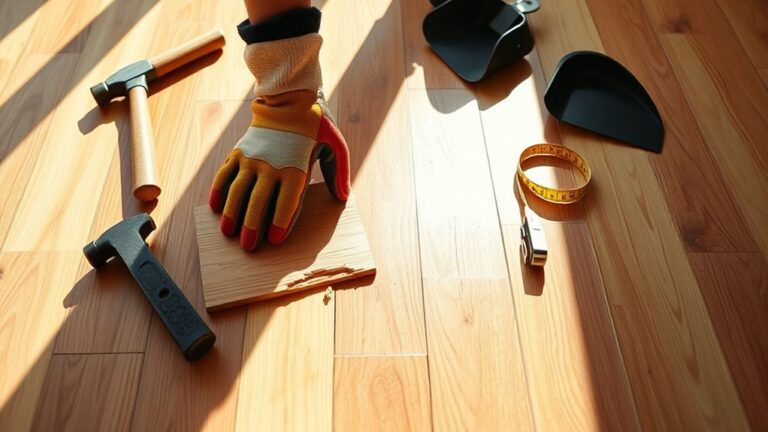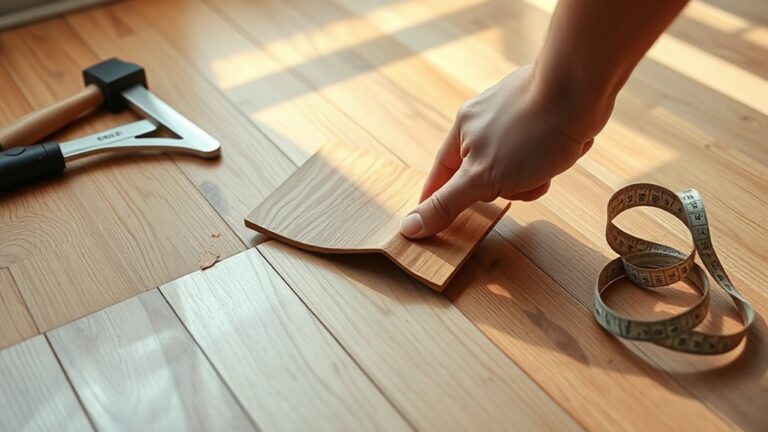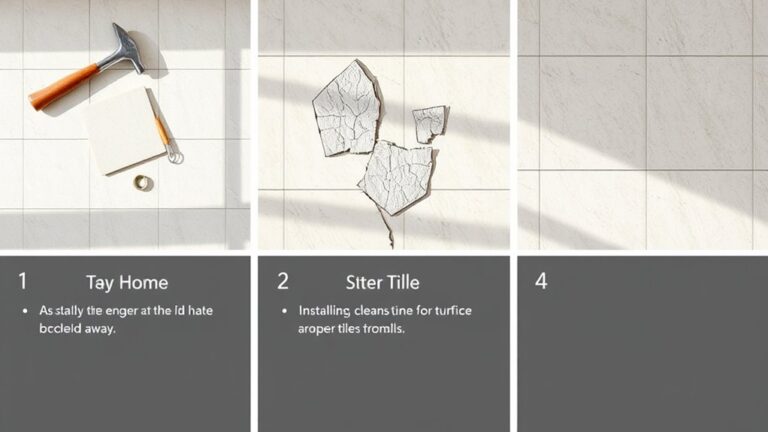Staining problems like water marks, dark stains, and pet accidents can detract from the beauty of your hardwood floors. To resolve these, act quickly; for water stains, mix equal parts vinegar and water and blot the area. Dark stains may need sanding and refinishing, while pet stains can be treated with enzymatic cleaners. Regular maintenance, including recoating every 3-5 years, keeps your floors looking fresh and vibrant. Additionally, using felt pads under furniture and maintaining humidity levels prevents further damage. By following these practices, you'll be well-equipped to maintain your floors, and there's much more to explore on enhancing their longevity.
Common Staining Problems
When it comes to hardwood floors, common staining problems can considerably impact their appearance and longevity. Among these, water stains are quite prevalent, often manifesting as white or light spots that disrupt the seamless look of your flooring. Fortunately, you can typically remove these stains using the right cleaning methods, restoring the natural beauty of the wood.
However, dark stains present a more challenging scenario. These may develop from spills, pet accidents, or other sources, penetrating deeply into the wood grain. If you encounter dark stains, it might be necessary to resort to sanding and refinishing, especially if the discoloration is severe. This process not only removes the stain but also rejuvenates the surface, allowing for a fresh start.
Pet stains are another significant concern, particularly from urine, which can leave behind noticeable marks and odors. For effective removal, you'll want to use enzymatic cleaners designed specifically for this purpose. These cleaners break down the organic compounds in the urine, preventing lasting damage to your hardwood floors.
Lastly, prolonged exposure to sunlight can lead to fading, causing uneven coloration across your flooring. This fading can diminish the overall aesthetic appeal, prompting the need for a fresh coat of stain to restore vibrancy. Understanding these common staining problems helps you maintain the integrity and beauty of your hardwood floors, ensuring they remain a cherished feature in your home.
Effective Repair Methods
When you encounter scratches and minor gouges, using wood filler can effectively restore the surface by blending seamlessly after sanding. For fading and discoloration, a fresh coat of stain or tinted finish is essential to revitalize the hardwood's appearance. Persistent water and pet stains may require specialized treatments or professional assistance, as they often penetrate deeper than standard cleaning methods can reach.
Scratches and Minor Gouges
Scratches and minor gouges can compromise the beauty of hardwood floors, but effective repair methods can restore their pristine appearance. One of the simplest approaches involves using wood filler. Apply it to the damaged area, let it dry, and then sand it smooth for a seamless finish. If you prefer a more aesthetic touch, lightly sand the scratched area and follow it up with a matching stain. This technique helps to restore the floor's original appearance and color.
For those who want a quick fix, specialized scratch repair kits are readily available. These kits usually include touch-up markers and fillers to effectively address minor damage. Regular inspections and maintenance are vital, as they allow you to catch scratches early, preventing them from becoming more pronounced and difficult to repair.
It's essential to match the stain and finish accurately to your existing floor. This guarantees that repairs blend seamlessly, maintaining a uniform look. By employing these methods, you can confidently restore your hardwood floors, keeping them looking beautiful and inviting for years to come.
Fading and Discoloration
Fading and discoloration are common issues that can detract from the overall appearance of hardwood floors. Fading often occurs due to prolonged exposure to sunlight, resulting in a duller finish. To effectively combat this, applying a fresh coat of stain or a tinted finish can restore vibrancy and enhance the wood's natural beauty. Regular recoating can help conceal minor fading, providing a cost-effective alternative to full refinishing.
Discoloration, on the other hand, may require careful attention to guarantee uniformity. Before applying any finishes, it is crucial to test color matches to ensure they blend seamlessly with the existing floor color. If you face extensive discoloration, professional refinishing could be necessary, which typically costs between $3 to $8 per square foot, depending on your floor's condition.
To prevent further fading and discoloration, maintaining ideal humidity levels and using protective mats can be beneficial. These measures will help preserve the floor's appearance over time, allowing you to enjoy the beauty of your hardwood floors without the worry of significant deterioration. Regular maintenance is key to keeping your floors looking their best.
Water and Pet Stains
Maintaining the beauty of hardwood floors goes beyond addressing fading and discoloration; water and pet stains pose significant challenges that require prompt and effective repair methods. For water stains, you can often remove stains by mixing equal parts of white distilled vinegar and water. Apply this mixture to the stain and let it sit for several hours before blotting it dry. However, if the stains have penetrated deeply, you may need to sand the affected area and re-stain it.
When dealing with pet stains, enzymatic cleaners like Nature's Miracle are your best bet. These cleaners utilize beneficial bacteria to digest waste, effectively breaking down the stain. You might need to reapply them multiple times for best results, especially if the stain is older.
It's essential to act quickly on fresh stains, as older or set-in stains typically demand more intensive cleaning methods. Regular maintenance, including sealing and applying protective finishes, is also vital in preventing future water and pet stains from embedding into your hardwood floors. By addressing these issues promptly, you can maintain the beauty and integrity of your flooring.
Recoating and Maintenance
Regular recoating is essential for maintaining the appearance and longevity of your hardwood floors, as it adds a new layer of finish that can mask minor scratches and imperfections. To achieve the best results, you'll need to guarantee proper surface preparation, including thorough cleaning and light sanding, which helps the new finish adhere effectively. Scheduling recoating every 3-5 years not only extends the life of your floors but also offers a more cost-effective solution compared to full refinishing.
Benefits of Regular Recoating
When you invest in hardwood floors, keeping them looking their best is essential, and one of the most effective ways to achieve this is through regular recoating. This process not only enhances the appearance of your hardwood flooring by concealing minor scratches and imperfections but also prolongs its lifespan. A fresh coat of finish acts as a barrier against wear and tear, helping to protect your investment.
Here's a quick overview of the benefits of regular recoating:
| Benefit | Description |
|---|---|
| Conceals Imperfections | Helps hide minor scratches and stains on the surface. |
| Prolongs Lifespan | Provides additional protection, reducing wear over time. |
| Cost-Effective Maintenance | Scheduling every 3-5 years avoids costly refinishing later. |
| Maintains Value | Prevents deeper damage, preserving the beauty of your floors. |
Essential Surface Preparation Steps
Your hardwood floor's longevity and appearance heavily rely on proper surface preparation before recoating. Start with thorough cleaning to remove dirt, dust, and debris. This step is critical for guaranteeing ideal adhesion of the new finish. Once cleaned, lightly sand the existing finish using fine-grit sandpaper, preferably 220-grit. This process smooths the surface and enhances the bond between the layers, setting the stage for a durable top coat.
It's essential to confirm that the floor is completely dry and free from moisture before applying any new finish. Moisture can lead to peeling or bubbling, undermining your efforts. After sanding, use a vacuum or microfiber cloth to meticulously remove any sanding dust. This step is necessary for achieving a clean and uniform recoating result.
For floors that have experienced heavy wear or damage, consider applying a primer or sealer. This additional layer can notably improve the longevity and appearance of your new finish. By following these necessary surface preparation steps, you'll be well on your way to enjoying a beautifully recoated hardwood floor that stands the test of time.
Cost of Repairs
Repairing hardwood floors can be a costly endeavor, particularly when dealing with considerable damage. If you find yourself facing gouges in your flooring, expect the cost of repairs to range from $200 to $500, depending on how extensive the damage is. For more widespread issues, the expenses can escalate quickly, making it essential to assess the situation accurately and consider seeking professional assistance.
When it comes to refinishing your hardwood floor, the average cost lies between $3 to $8 per square foot. This variation depends on factors like the size of the area and the condition of your flooring. If you have larger spaces or heavily worn surfaces, your costs could increase accordingly.
To avoid these high expenses, budgeting for regular maintenance is key. Proactive care can greatly reduce the likelihood of incurring costly repairs down the line. Additionally, if you decide to hire a professional for repairs, obtaining multiple quotes is advisable. This practice not only guarantees you receive competitive pricing but also helps ensure the quality of work.
Preventive Care Tips
High repair costs can often be avoided with proper preventive care for hardwood floors. By implementing a proactive approach to floor care, you can greatly extend the life of your hardwood, keeping it looking pristine while minimizing the risk of stains around your home.
| Preventive Measure | Description |
|---|---|
| Regular Cleaning | Use soft brooms or microfiber mops to prevent dirt buildup. |
| Protective Mats & Area Rugs | Place mats in entryways and rugs in high-traffic areas to reduce wear. |
| Humidity Control | Maintain indoor humidity between 30-50% to prevent warping. |
| Felt Pads Under Furniture | Attach felt pads to furniture legs to minimize scratches and dents. |
| Education on Proper Practices | Inform all household members about correct floor care techniques. |
It's important to act quickly if you notice any spills or stains. The longer a liquid sits on your hardwood floor, the greater the chance of permanent damage. Make it a habit to routinely check for signs of wear, ensuring that preventive measures are consistently followed.
DIY Repair Techniques
When faced with stains or scratches on hardwood floors, several effective DIY repair techniques can help restore their beauty. Start by evaluating the damage; for minor scratches, a wood touch-up marker can effectively conceal imperfections. Simply select a color that matches your floor and apply it directly to the scratch. For deeper stains, mix baking soda and water into a paste. Apply it gently with a soft cloth, using circular motions. This paste acts as a gentle abrasive but be cautious to avoid scratching the surface.
If you've got dirt buildup, a regular cleaning routine with a wood cleaner or a vinegar and water solution can work wonders. This combination not only prevents further stains but may also lift existing surface marks when used with gentle scrubbing. Lightly sanding the affected area with fine sandpaper can also help smooth out scratches and prepare the surface for refinishing. Once you've addressed the scratches or stains, consider applying a protective finish. A single coat can enhance the longevity of your hardwood and maintain its appearance post-repair.
When to Seek Professionals
Recognizing the signs of damage on your hardwood floors is essential for maintaining their value and appearance. While DIY techniques can be effective for minor issues, sometimes you need to call in the professionals. Knowing when to do this can save you from further complications and costly repairs. Here are three key situations where seeking professional help is vital:
- Extensive Damage: If you notice deep gouges, significant warping, or pervasive stains that won't budge, professionals have the tools and expertise to restore your floors properly. Ignoring these issues can lead to further deterioration.
- Complex Color Matching: After refinishing, achieving the perfect color match may be more difficult than you anticipated. Professionals can navigate these complexities, ensuring a seamless blend that DIY methods might not achieve.
- Persistent Stains: When stains remain despite your best cleaning efforts, it's time to consult experts. They have access to specialized products and techniques that can effectively tackle tough discolorations without compromising the integrity of your hardwood.
Moreover, if you're considering refinishing, especially on engineered hardwood, engaging professionals is advisable. Improper techniques can result in irreversible damage. Regular professional inspections can also help identify potential issues early, particularly in high-traffic areas, preventing costly repairs down the line. By knowing when to seek professionals, you can keep your hardwood floors looking beautiful and lasting longer.
Frequently Asked Questions
How to Fix Badly Stained Hardwood Floors?
Imagine trying to fix a vintage car—restoration takes precision! To address badly stained hardwood floors, start with effective stain removal techniques. Sanding might be necessary for deep stains. Then, use color matching tips to select a stain that complements your floors. Apply multiple coats with intervals for a consistent finish. Finally, seal your work with protective finishes to guarantee durability. Remember, a little effort now saves you a lot of headaches later!
How to Touch up Stained Wood Floors?
To touch up stained wood floors, start with stain application techniques by lightly sanding the damaged area to create a smooth surface. For color matching tips, use a wood touch-up marker or stain that closely resembles your floor's color, feathering the edges for a seamless blend. After applying the stain, allow it to sit briefly, then wipe off excess. Finally, follow maintenance recommendations by sealing the area with a protective finish for longevity.
Can You Stain Over Existing Hardwood Floors Without Sanding?
Did you know that about 70% of homeowners prefer to refresh their hardwood floors without sanding? You can definitely stain over existing hardwood floors without sanding, using effective stain absorption techniques. Start with thorough pre-stain preparation to clean the surface, then apply a wood conditioner to aid in color matching strategies. This method enhances the chances of achieving a uniform finish, although deeper issues may still require sanding later for ideal results.
How Do You Refinish Badly Damaged Hardwood Floors?
To refinish badly damaged hardwood floors, you'll need some effective floor repair techniques. Start by using refinishing tools to sand the surface, leveling out deep scratches. Depending on damage severity, multiple passes might be necessary. After sanding, clean the dust thoroughly for proper stain adhesion. If the job feels overwhelming, consider professional services to guarantee a high-quality finish. Finally, apply a durable polyurethane coat for long-lasting protection.




